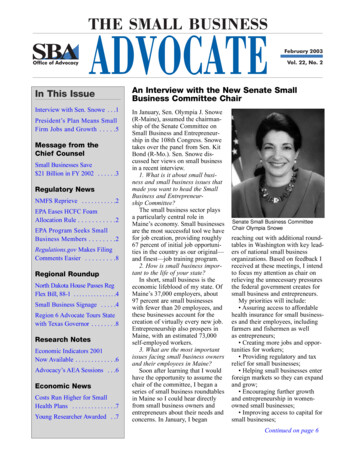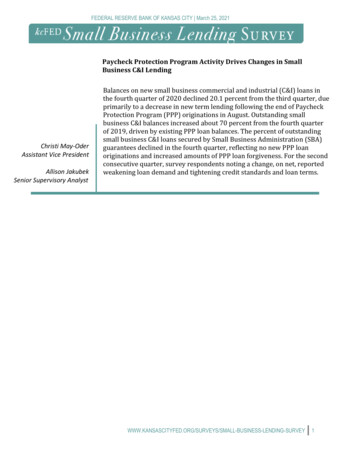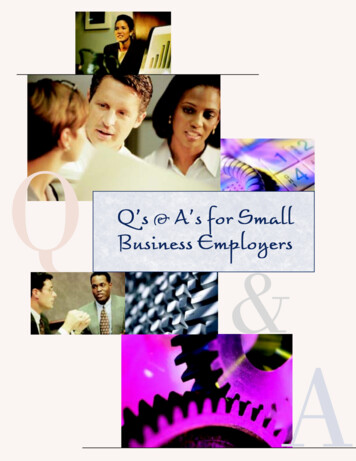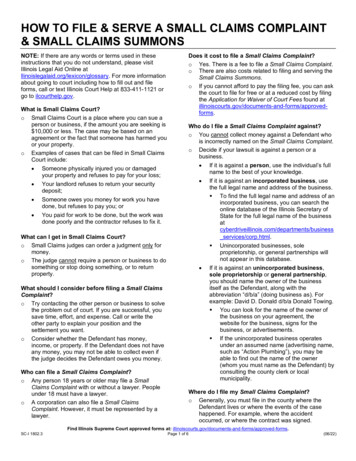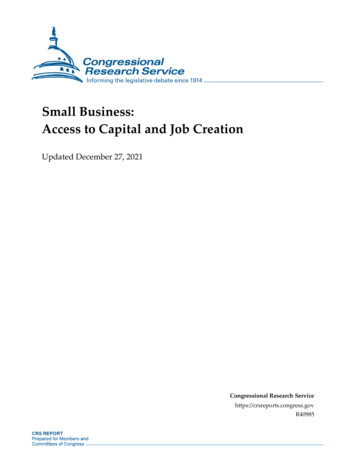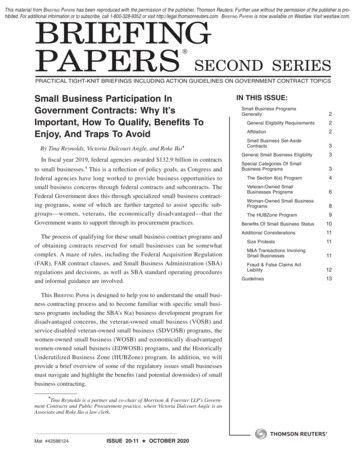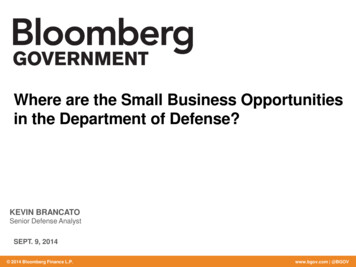
Transcription
State ofSmallBusinessReportFA C E B O O K &SMALL BUSINESSR O U N D TA B L EVol 1United States of AmericaMay 2020
Executive summarySmall and medium-sized businesses in the United States are being hit hard by theCOVID-19 crisis.As part of our ongoing data collection effort with the World Bank and the OECD on theFuture of Business, Facebook conducted a survey, in partnership with Small BusinessRoundtable, of approximately 86,000 people who owned, managed or worked for a smalland medium-sized business (“SMB”), including approximately 9,000 operators of “personal”businesses, i.e. people who reported that they were “self-employed providing goods orservices” or that they “produce goods sold for personal income” but did not otherwiseself-identify as an “owner” or “manager” of a business.The results provide a better understanding of which businesses are still operational andwhich are not, where they are located, and what their most pressing needs are. Here arethe key results:01Small businesses are closing their doors and facing anuncertain future. 31% of owners and managers reported that their SMB is not currently operating. Among personal businesses, that number rises to 52%, of which the majority(55%) were led by women.02 SMBs’ biggest challenges are access to capital andcustomer behavior. 28% of SMBs said the biggest challenge they would face over the nextfew months was cash flow. 20% said their biggest challenge would be lack of demand.03 To adapt to the ongoing crisis, SMBs are turning tointernet tools. 51% of businesses report increasing online interactions with their clients. 36% of personal businesses that use online tools report that they areconducting all their sales online. 35% of businesses that have changed operations have expanded theuse of digital payments.2
EXECUTIVE SUMMARY04 Small business owners are struggling to balance running abusiness and caring for their households. Nearly half (47%) of SMB owners and managers report feeling burned out tryingto take care of business and household responsibilities at the same time. 62% of respondents report spending between one and four hours a day ondomestic or household care activities. More women owner-managers (33%) reported that household responsibilitieswere affecting their ability to focus on work “a great deal” or “a lot” thanmen (25%).05 Employees are facing dire economic circumstances. Large majorities of employees don’t have access to paid sick leave (74%) or paidtime off (70%); among hotel, cafe and restaurant employees those numbers rise to93% and 94%, respectively. Only 45% of owners and managers of SMBs reported that they would rehire thesame workers when their businesses reopened. The same was true for 32% ofpersonal businesses.06 Still, SMB owners and managers remain optimistic and resilient. 57% of SMBs report that they are optimistic or extremely optimistic about the futureof their businesses. Only 11% of operating businesses expect to fail in the next three months, shouldcurrent conditions persist.3
Table of contentsIntroduction. 05About the report. 06Definitions. 06Section 01COVID-19 is having a devastating impact on SMBs .07Section 02 People and businesses are making serious efforts to adapt . 11Section 03 But it’s not enough. People are going to need more help. 16Conclusion. 21Appendix 01. 22Appendix 02. 24Appendix 03. 28Survey methods overview. 33Acknowledgements. 34
IntroductionSmall businesses are the heartbeat of our communities—and they’rein real trouble. The pandemic isn’t just a public health emergency,it’s also an economic crisis. Since the first shelter-in-place orders,it has been clear that many businesses were going to take a big hit,but now we can hear from the people behind the businesses justhow big a hit they are taking.This is the first in what will be an ongoing series of reports uncovering the situationfacing American businesses. These were planned before the virus struck, when wehad anticipated this first report would paint a much brighter picture. Instead, it bringshome the scale of the crisis that our economy is facing and helps point to where helpis most needed.This report shows that, as of April 2020, nearly one-third of small and medium-sizedbusinesses have stopped operating. For the smallest businesses – those run by theself-employed or for personal income – the situation is worse. More than half areno longer operating. That is especially bad for women, who run the majority ofthese businesses.Still, the survey shows, the people who operate, manage and work for SMBs areresilient; among them, there is hope and optimism about the future of their businesses.They’re finding new ways to reach their customers online, they’re making adjustmentsto how and when they do business, and they’re working hard to meet their familyobligations at the same time.Whatever comes next, Facebook and Small Business Roundtable will continue to workwith SMBs to help them adjust to this new reality and reboot as we move forwardas a nation.Sheryl SandbergCOO, FacebookJohn Stanford & Rhett ButtleCo-Executive Directors, Small Business RoundtableMay 2020
About the reportSmall and medium-sized businesses have been disproportionately affected by thecircumstances around COVID-19. At the same time, policymakers and researchers arefacing challenges obtaining timely information about the needs and outlook of SMBs.We know many of the owners and operators of these businesses are on Facebook,and wanted to use our platform to provide insight on the impact of COVID-19 onthe SMB economy.We surveyed approximately 86,000 SMB owners, managers and employees aboutthe kinds of businesses they operated or worked for, whether those businesses wereoperational or not, how many people they employed, what kind of access to capitaldid they have, and what they expected their biggest challenges to be in the comingmonths. The survey also inquired into how people’s family obligations were affectingtheir ability to work, whether they had access to information about available resources,asked people about their long-term business survival strategies and whether they werehopeful things were going to improve.All quotations in this report were sourced from a supplemental survey fielded tothe same population two weeks after the original survey to gather more qualitativeinsights into the experiences of small and medium-sized businesses.Definitions “Owners and Managers” refers to respondents who reported that they“manage day-to-day operations of a business” or “own a business.” “Personal” businesses refers to respondents who reported “self-employedproviding goods or services” or that they “produce goods sold for personal income.”(Examples of "personal" businesses include: selling clothing, making and sellinghandicrafts, freelance writing, photography services. Personal businesses mayor may not be full-time or part-time ventures and may or may not have employees.) People who reported “working as a business employee/worker” as their onlyresponse were considered “Employees.”6
Section 01COVID-19 is having a devastating impact on SMBs.The lockdowns and social distancing, both mandatory and voluntary, occasionedby COVID-19, along with the concomitant decline in demand for in-person goodsand services have had a devastating effect on America’s SMBs.Business ClosuresAccording to the survey, 31% of small and medium-sized businesses have shut downin the last three months. The situation is worse for personal business (52% of whichreport shutting down), hotels, cafes and restaurants (43%) and services like wellness,grooming, fitness or other professional services (41%).̋We have lost almost all clientele,and can not afford to pay for ourhome and bills. Of the businesses that report being closed,71% report having closed since March 1, 2020,18% closed in February and 4% closed in January.Chart 01 provides a summary of the percentageof businesses that have shut down in the last threemonths, by industry. Chart A3-1 and Chart A3-2in Appendix 3 contain breakdowns by genderand by region.Businesses not currently operational or engagingin any revenue-generating activitiesCHART 01by Industry50%40%30%20%10%0%Agriculture ervices7
SECTION 01Among the reasons self-cited by closedbusiness owners as to what, in particular,caused them to close: a majority (62%)said it was necessary to comply withorders by governments or healthauthorities, while a smaller share claimedit was due to financial challenges (9%)or a lack of client demand (7%). The datarevealed some minor variations in thereasons cited for closing, e.g., constructionfirms were more likely to cite logisticalchallenges (8% cf. 2% overall), informationand communications SMBs cited financialchallenges (23% cf. 9% overall), andbusinesses led by women were morelikely than businesses led by men toself-cite local ordinances (66% cf. 58%).As an indication of potential resourcesavailable subsequent to closure, only 7%of owners and managers (and 3% ofpersonal businesses) reported havingbusiness interruption insurance.A FOCUS ON EmployeesMany of the respondents to our surveywere people who, until recently, worked foran SMB. Their experiences are varied, buttheir responses share a common theme:they’re under stress, but remain optimistic.̋I was laid off and now am not beingbrought back. My business isn’tmaking any money currently. Of the 96% of SMB employees who reporthaving a job in 3 months prior to the survey,74% worked full time and 20% worked parttime. And now, 29% of those samerespondents report not working at all—44%of whom because the business they workedfor has shut down, 22% because they werelet go and 10% because of local ordinancesto shelter-in-place or quarantine.Small Business EmployeesEven when businesses remain open,employees are experiencing financialcuts from lost employment or fewer hoursworked. While 3% of businesses reportedthat their employee headcount actuallyincreased, 44% said they had to reduce thenumber of employees or workers at theirbusiness because of the pandemic.Of businesses that reduced headcounts,22% let go more than 10 people. Largerlayoffs of more than 50 employees hit theMidwest the hardest (13% of businesses cf.5% overall.)Any time a business closes or has to layoff workers, it affects entire communitiesof people who rely on income from jobs tosupport themselves, and in turn, supportother local businesses and organizations.Some 65% of owners and managers whoemployed more than one person reportedthat, since their business closed, theirworkers were unable to get any additionalsalary or wages, end of service bonuses,unemployment benefits, or any discountedor partial health insurance. In keepingwith a trend, for personal businessesthat number rose to 77%.Regardless of one’s employment situation,reliable resources are scarce or vulnerable.Only 25% of employees reported beingable to rely on household income from aspouse or partner, only 19% reportedaccess to personal savings. A large shareof respondents said they don’t have paidaccess to sick leave (74%) or paid time off(70%). Only 19% of retail employees reportaccess to hazard pay. And among hotel,cafe, and restaurant employees, 94%reported no access to paid time off, 93%no sick leave, and only 18% said theyhave access to health insurance.8
SECTION 01Unemployed Small Business WorkersJob prospects for unemployed SMBworkers remains uncertain. Accordingto the survey: only 45% of owners andmanagers of closed businesses reportedthat they would rehire the same workerswhen their businesses reopened, while32% of personal businesses said theywould do the same. When responseswere analyzed by industry, 63% of hotels,restaurants, and cafes expressed plansto rehire the same employees, while amongfirms in the agriculture, forestry, fishing,and mining fields, this number falls to 27%.Also noteworthy: 19% of owners andmanagers of closed businesses reportedthey were keeping their workersand still paying part of their wages;for personal businesses, 9%.As might be expected, people are focusedon the essentials. Their top concernswere having enough money to sustaintheir household (51%) and having foodand basic supplies (46%). Relatedly, only11% of employees report having appliedto receive any government or NGOassistance in response to the pandemic.Still, people remain hopeful. 59% of boththe employed and unemployed were atleast somewhat optimistic about theirfuture employment, while 16% weresomewhat pessimistic. Notably, andperhaps unsurprisingly, employees ofhotels, restaurants, and cafes weremore pessimistic about their employmentprospects, with 24% reporting at leastsomewhat pessimistic.9
Section 02People and businesses are making serious efforts to adapt.D̋ espite the 50% decline in sales we stillhave to pay 100% of our fixed costs.This is impossible. Rent was already high.Now it makes up 50% of our gross income. Operational businesses might be openand running, but they still reportsignificant challenges accessing thecapital they need to stay afloat, keepingtheir supply lines open, making suretheir employees can work remotely, andbalancing increased family demands.Prospects of ReopeningOwners and managers of SMBs are knownto be resilient, but times are tough. Whiletwo-thirds of closed businesses expect tore-open in the future, including a slightlyhigher percentage of women than men(71% to 62%, respectively), among theone-third who did not, 34% said it will bebecause they can’t pay their bills or theirrent (55% in the Midwest). Only 15% ofowners and managers of personalbusinesses also cited financial pressure—27% said they did not expect to re-openfor “personal reasons.”And even when the time comes to re-open,the path forward is not always clear. While41% of owners and managers say they planto use personal savings to reopen theirbusiness when the time comes, 39% do notknow where they’re going to get the money.Again, personal businesses face a differentreality: only 28% plan to use personalsavings, while 53% are uncertain whereWorkloadOne way to gauge the relative health ofan operational business is to query theirworkload. Whether a business owner ormanager reports that they are workingmore or less can serve as an initial indicatorof other long-term trends relative to thehealth of their business, i.e., as the crisisprogresses, will they be making enoughmoney to get by?Which business reported ahigher workload? There was slight regional variation amongbusinesses reporting a higher workload, with24% from the Northeast, cf. 14% from the West. In order to accommodate changing consumerbehavior related to particular goods andservices, these businesses reported: extendingoperating hours (24%), hiring more employees(14%), and increasing supplies (14%),among other strategies. Comparing sales over the last 30 days with thesame time in 2019, 15% of businesses reportedan increase, which when analyzed by gender,revealed a small variant (18% of women cf.13% of men.) Still, although fewer men reported an increasein sales, their relative increase was higher,with 35% of men reporting an increase of 100%or more, cf. 11% of women.Note: Chart A3-4 and Chart A3-5 show reporteddifferences in sales broken down by gender ofowner and industry, respectively.the necessary funds will come from.10
SECTION 02Our research showed that, as might beexpected during a time of serious upheaval,some businesses are indeed seeing higherworkloads, including: 17% of all operationalbusinesses and 24% of retail operations.Indicative of the facts on the groundhowever, most operational SMBs—a full60%—reported a lower workload; includingin particular, compared to 65% of personalbusinesses and 70% for hotels, cafes andrestaurants, again suggesting a locus ofthis crisis.Finances and Access to CapitalThree out of five businesses surveyedfor this report (60%) say that they arestruggling with some aspect of theircompany’s finances. For businesses inthe American West, it was 65%.In particular, people reported their chiefconcerns with respect to finances andcapital were: paying their workers’salaries and wages (29%) and paying theirbills (28%). For hotels, restaurants andcafes, those numbers rose to 44% and54%, respectively.Chart 02 details these areas of concernsfor businesses and personal businesses.Chart A3-6 provides in Appendix 3 providesa breakdown by industry.̋[We need] funds to pay rent and leasepayments after being forced to shut down.We have no income coming in and no way tocover our bills. Our landlords both personaland professional still need to be paid. Approximately 40% of businesses reportedthat their cash outflow has been greaterthan inflow over the past 30 days. Forservice-oriented SMBs that number rose to49% and construction-related SMBs, 55%.Areas of financial concern—Personal vs Formal businessesCHART 02Cash Flow in Past 30 Days60%50%40%30%20%10%0%TaxesRent orLeaseOtherNoneof theAboveEmployee EmployeeWages orHazardSalariesPayEmployeeWorkerBenefitsDepts orLoansBills orAccountsPayableI don’t %30%35%40%45%11
Cash flow in past 30 daysCHART 0345%40%35%30%25%20%15%10%5%0%Outflow isless thaninflowOutfow isgreater thaninflowAll this thrash resulted in cash flowappearing high on the list of pressingconcerns for operational businesses:76% report being either very or somewhatconcerned about their cash situation inthe coming three months.Chart 03 provides response rates on thestate of cash flow for businesses overthe past 30 days.Outflow is aboutthe same asinflowI don’tknowSMBs had more access to gift cards (15%).Businesses are also turning to institutionsfor help. When asked what was the onething that would most help their businessadapt to the pandemic, 45% of operatingSMB owners and managers said zerointerest loans or other financial assistance.To make ends meet, 41% of businessesowners and managers reported theycould draw from personal savingsaccounts, 11% from family and friends,7% from community donations, and 4% from gift cards for clients. Interestingly,information and communication SMBshad more access to community donations(at 18%), while hotel, cafe and restaurant12
Most needed policies to support businessesduring the COVID-19 crisisCHART 0445%40%35%30%25%20%15%10%5%0%Access toloans andcreditguaranteesGovt.purchaseof goods e owner or managerHalf of SMBs (50%) reported applying togovernment sources for capital support inthe 30 days prior to the survey fielding, 11%for traditional bank loans and 6% for capitalgrants from the private sector. Variations inthese figures were noted for personalbusinesses, ranging from 25%, 4% and 6%respectively. For businesses in the Midwest,these figures are higher: 60%, 16% and 9%,respectively. Other regions lackedsignificant variation.Chart 04 provides a full breakdown onpotential capital sources for traditionaland personal are ofhouseholdmembers &dependentsTaxdeferralUtilitysubsidiesFemale owner or managerSupply ChallengesAs the crisis grinds on, supply lines remain anongoing, possibly underappreciated concern.Of the SMBs surveyed: 40% of ownermanagers reported facing supply challenges,including 67% of retail SMBs, 35% of personalbusinesses and 50% of hotels, cafes, andrestaurants. Specifically, they reported theywere finding limited supplies of a specificproduct (61%), and delayed shipments (56%).In this context, entrepreneurial flexibility is akey to helping businesses pull through thepandemic. To keep supplies flowing, 13% ofbusinesses are using new suppliers, 18% havedelayed orders, and 24% have adjusted theirdelivery schedules (including 18% who citedchanging delivery procedures suggestingsafety is a concern). Businesses led by menhave engaged in these behaviors slightlymore, with 21% changing delivery proceduresand 20% delaying orders (cf. women at 15%and 16%, respectively).13
SECTION 02While many of the people we surveyedhave been vigilant and proactive aboutkeeping customers, employees, familymembers, and their communities safe fromthe virus (48% reported cleaning theiroffices and work spaces more frequently,45% report providing gloves, masks, handsanitizers, or other protective equipmentto their workers), 47% reported that theywere also facing sanitation or cleaningsupply shortages.And in a related finding, 51% of ownermanagers report increasing onlineinteractions with their clients to reducethe spread of the virus, in addition tocleaning more often.A FOCUS ONPersonal BusinessBy opening up new avenues ofcommunication, the internet has enablednew opportunities for people to run“personal businesses.” Within this survey,this term refers to people who respondedthat they were “self-employed providinggoods or services” or that they “producegoods sold for personal income” but whodid not otherwise report being involvedin a business. For example: consider aperson who sells homemade flowerpotsthrough Facebook Marketplace: it mightbe their primary source of income or itmight be a “side hustle,” they may be asolo-prenuer or they might employ others.What matters for the purposes of thissurvey is that they are engaged in thisactivity, do not identify as an employeeand did not otherwise self-identify as a“business owner or manager.”In this survey, 9% of respondents(approximately 9,000 people) representedthemselves as “personal businesses,” overhalf (55%) of which were led by women.As evidenced by the data, the economicturmoil unleashed by COVID-19 is strikingpersonal businesses particularly hard.They are more likely to report being outof operation (52% cf. 31% of more formalSMBs), more likely to struggle from basicoperational issues like logistics andsupplies, and less able to support remotework long-term (55% cannot sustainworkers working from home for more thana few days).The people who run personal businessestend to report having less access tosources of money such as wage and jobincome, personal savings, and incomefrom another business, and consequently,more difficulty paying their householdexpenses (40% cite this difficulty cf. 33%of owners and managers of moreformal businesses).While entrepreneurial flexibility is a majordetermining factor in helping businessesmake it through this crisis, personalbusinesses are at a disadvantage: only65% said they’ve made a change toaccommodate clients or customers.Possibly evincing a steeper digital onramp,personal businesses report using theinternet less than their formal counterpartsto help customers adapt: only 24% say theyhave expanded the use of digital paymentsand only 35% are offering online services.14
SECTION 02Turning to TechnologyFor many small businesses, the internetremains a lifeline.Seventy-nine percent of businesses saythey’ve made a change to operations toaccommodate clients and customers,including things like expanding the useof digital payments (35%), and offeringcurbside or home delivery (23% and 24%,respectively). Businesses in the Southeastreported slightly more use of physicaladjustments, with 27% providing curbsidedelivery and 27% providing deliveryat home.More broadly, the internet is helpingbusinesses continue to operate duringthe pandemic; in the 30-days prior to thesurvey fielding: 23% of businesses reportedusing digital ordering tools, 16% servicedelivery tools, and 37% digital paymenttools. Thirty-six percent of operationalpersonal businesses that use online toolsreport that they are conducting all theirsales online.̋My company has Webex meetingsand team sites. We were able to bringhome our work set up includingchairs and standing desks. I havefiber optic internet at home. I'm set. In the end, these tools are not a panacea.According to the survey, about half ofbusinesses (51%) report that a majorityof interactions between clients/customersand employees/workers need to beconducted in the same physical location.Similarly, 35% of operational businessowners/managers report that they cannot work remotely, as did more men (42%)than women (28%). There is notable, butexpected variation by industry. While 17%of information and communication SMBmanagers say they could not work fromhome at all, 67% of hotels, cafes, andrestaurant owners and managersreported the same.Businesses led by women are more likelyto be using digital tools, particularly withonline advertising (43%) and digitalpayment tools (40%), compared to just37% and 34%, respectively, of businessesled by men. More generally, 40% ofbusinesses (and even 31% of personalbusinesses) are making use of onlineadvertising to continue operating duringthis pandemic.As for how well these tools are servingthe needs of SMBs: 56% of business leadersthat use online tools said their businessmakes at least half their sales digitally.Again we find that women-led businessesare making more use of online sales, with59% saying at least half of their sales aredigital compared to 54% of businessesled by men.15
Section 03But it’s not enough. People are going to need more help.̋My business needs the economy opened up. Small businesses aresuffering and no amount of stimulus money can replace a thrivingand functional business. At the time of this report, it remains unclearwhen COVID-19 will abate, what conditionsare necessary for that to occur, and whatbusiness will look like going forward. Manybusiness owners are worried. Our surveyin April captured some of this foreboding.Of those businesses that are currentlyoperational, 11% said that they did notexpect to continue in operation beyondthe next three months should currentconditions persist.When business leaders considered theirgreatest challenges over the next fewmonths, 28% cited concerns about cashflow and 20% worried about lack of demand.That is: businesses said they need accessto capital and they need customers.Preparing to ReopenFor many businesses, demand will be afunction of how close to “normal” conditionsare after COVID-19 abates. Businesseswill continue to be affected by the durationof shelter-in-place orders, the extent ofrestrictions as society begins to re-open,the public’s perceived risk in engagingwith particular businesses, and the overalleconomic situation that will influenceconsumer and corporate spending.Among owners and managers of closedbusinesses: 57% said that the mostimportant action that had to take placefor their business to reopen was for thegovernment to allow operation; another20% said securing funds.Currently, just 28% of all surveyedbusinesses report having a line of creditor a loan from a financial institution.And as previously noted, 41% of ownersand managers plan to use personalsavings to reopen their business whenthe time comes while 45% of operationalbusinesses reported zero-interestloans or other financial assistance astheir most pressing need.Midwestern businesses were more likelyto report receiving financial support—with40% saying they already have a credit lineor loan, compared to 23% of Northeasternbusinesses, 26% of Southeastern businesses,and 24% of Western businesses.16
SECTION 03Addressing New FearsAs business owners and managers consider their options, they worry about the risksof getting a loan or opening a line of credit. Despite their need for access to capital,47% of open businesses were afraid of borrowing money — unsure if or how they couldpay it back. Just over half of operational business owners reported that they haveaccess to personal savings, but were not clear if it would be enough to save theirbusiness. And personal businesses expressed heightened uncertainty about whereto apply for loans in the first place.Chart 05 details areas of concerns for traditional and personal businesses.When asked what were their three most desired policies to help keep their businessesopen, owners most often cited: credit access and guarantees (36%), salary subsidies(38%) and tax deferrals (34%). Reflecting the fact that attending to domestic work isintegral to one’s overall ability to work, owners and managers also cited the need forhelp taking care of household members (23%). Women reported this need more oftenthan men (27% cf. 19%).Main challenges to capital/funding—Personal vs Formal businessesCHART 0560%50%40%30%20%10%0%I am afraid ofborrowing moneybecause I am notsure can pay it backI am going intodebt and do notknow howto handle itI do not knowhow to applyfor a loanAll businessesI do not know whereto get the moneyI need to keep thebusiness openOtherPersonal businesses17
SECTION 03SECTION 03Finally, despite public discussion aroundthe issue, only 9% of businesses listedexemptions from Social Security taxes asone of their top three desired interventions.Chart 06 breaks down these policies byresponse rate for female and male-ownedbusinesses. Chart A3-7 in Appendix 3 showsa breakdown by industry.A FOCU
Future of Business, Facebook conducted a survey, in partnership with Small Business Roundtable, of approximately 86,000 people who owned, managed or worked for a small . 04 Small business owners are struggling to balance running a business and caring for their households. Nearly half (47%) of SMB owners and managers report feeling burned .
